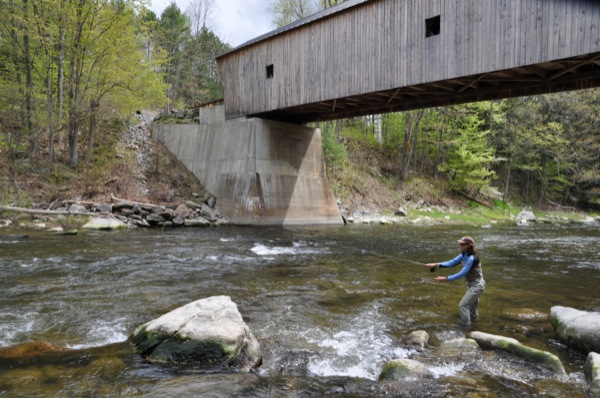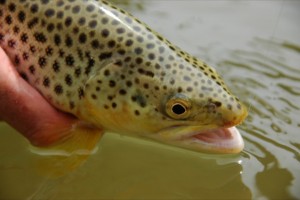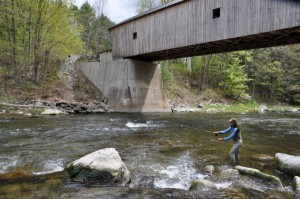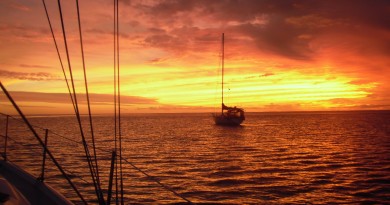Fly-Fishing for Fitness

For an avid runner, Nordic skier, or cyclist, fly-fishing is not going to get you in shape for your next marathon or century ride, but it doesn’t have to be a poke around the park either.
Fly-fishing requires both physical and mental skill, and depending on where you choose to cast a line, it can also give you a good work out.
I threw my first fly into Lake Mitchell in Sharon, Vermont, during the spring of 1985, just after ice-out. I was a professional athlete at the time, training and competing on the women’s pro ski tour. As my sweetheart rowed me around the lake, I tried again and again to place a tiny bug-like ball of feathers next to rocks and logs in the water. In reality, I spent most of the evening extracting the tiny ball of feathers from a large ball of bright orange line to which it seemed interminably entangled.
As darkness descended on the lake, I cast one last time. I suddenly felt a sharp tug and then a frantic wiggle. My heart pounded and adrenaline coursed through me as a rainbow trout jumped a foot off the water near the boat. A few minutes later, I gleefully pulled a tired 12-inch pink-sided fish out of the water. Fly-fishing might not be an aerobic sport, but it can sure get one’s heart rate up! I was thrilled to hook my first fish. What I didn’t realize was how that first fish had hooked me on fly-fishing.
Over that first summer, I was content to row around Lake Mitchell, perfecting my casting technique and reeling in cooperative trout. When it was my turn to row, I got a modicum of upper body exercise, and I relished the time outdoors, but eventually I wanted more: different types of fish, larger fish, and greater use of my legs.

The following May, I received a pair of Orvis waders and wading boots for my birthday and started exploring the rivers throughout the Green Mountain State. In addition to rainbow trout, wading putting my hook in front of lunker brown trout that lurked in the Black River near Cavendish and the White River near Bethel, and small but feisty brook trout in the Ompompanoosuc River near Stratford. The moving water also added several fly-fishing challenges and a few fitness benefits.
Negotiating the slippery rocks and remaining upright against persistent current improved my balance and my ankle and leg strength. I also learned how to be stealthy, to cast in a variety of ways, and to choose the correct fly based on what was floating in or hatching off the water. But mostly I enjoyed the time outdoors, the art of casting, and the aesthetics of the Vermont woodlands and hills that rolled lushly to either side of each stream into which I stepped.
Then, the opportunity to go backpacking in the Lye Brook Wilderness arose, which introduced me to backcountry angling. Suddenly, fly-fishing was truly a workout. The 16.5-mile, three-day trip began in Manchester, Vermont. The first day, I trekked along the Branch Pond Trail to Bourn Pond; the second day, I scrambled through a microburst area en route to Stratton Pond; and the third day, I passed over the Winhall River, following the Long Trail back to the trailhead in Manchester. My fishing gear added to the load on my back, but the brook trout were cooperative in all three waterways, perhaps because they had less fishing pressure than places closer to civilization.
Since that trip, my key criterium for choosing a backpacking route is the chance to go fly-fishing. There’s nothing more satisfying than hiking into a remote mountain pond, casting a line, and feeling the telltale tug. It’s great exercise, great fun, and best of all, a great escape.
GEARING UP
Got desire but not the gear? It doesn’t take much to get into fly-fishing. The Vermont-based Orvis Company offers a complete freshwater fly-fishing outfit that includes a versatile Streamline 5-weight rod, Clearwater III reel with a floating line, a 9-foot leader (the clear monofilament between the end of the line and the fly), and 150 feet of backing (extra line under the floating line in case a strong fish makes a really long run). The package includes a carrying case and a copy of The Orvis Guide to Beginning Fly Fishing. $225; orvis.com.

PICKING THE RIGHT FLY
Local fly-fishing shops always know what’s fishing best in their local water at a particular moment in time. Take their advice, not only the type of fly but also its size. When in doubt, a “black woolly bugger” and “muddler minnow” are good backups in most Vermont lakes and rivers.
FINDING FISH
Each year, the Vermont Fish and Wildlife Department stocks about 9,000 “trophy” (2-year-old) fish on nearly 27 miles of designated trophy streams and rivers and 18 lakes and ponds. Another 235,000 yearling landlocked salmon, brook trout, brown trout, rainbow trout, lake trout, and steelhead trout are added annually to more than 500 miles of rivers and streams and almost 60,000 acres of lakes and ponds. For the most up-to-date stocking report, go to anr.state.vt.us/fwd/stockingschedule.aspx
FLY-FISHING, A VERMONT SPORT
There are few places with as long a history in a sport as Vermont and fly-fishing. In 1856, Charles Frederick Orvis founded The Orvis Company in Manchester, Vermont. The fourth of seven children in a post–Revolutionary War, rural family, Orvis developed an interest in outdoor pursuits, including fishing, at an early age. He started building rods in his 20s for himself and his friends as a hobby.
In the mid-19th century, Orvis’ brother Franklin opened a hotel that would become the Equinox House, and Charles opened the Orvis Hotel on the same street. He offered fishing as an activity to guests of both establishments. As an ever-increasing number of affluent tourists visited Manchester via trains from New York and other cities, Charles turned his hobby into a business, opening a fly-fishing store next to his brother’s hotel and began selling his wares via mail order. Today, The Orvis Company employs several hundred Vermonters and includes an extensive network of retail stores, e-commerce and mail-order catalogs, fly-fishing schools, certified guides, travel services, and conservation programs.

